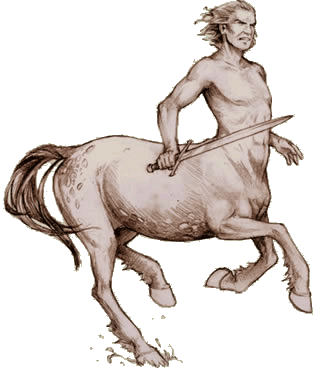|

|
In Greek
mythology, the centaurs (from Ancient Greek: Κένταυροι - Kéntauroi) are a composite race
of creatures, part human and part horse. In early Attic and Boeotian vase-paintings, as on the kantharos (illustrated below
left), they are depicted with the hindquarters of a horse attached to them;
in later renderings centaurs are given the torso of a human joined at the waist
to the horse's withers, where the
horse's neck would be.
This half-human and half-animal composition has led many writers to treat
them as liminal beings,
caught between the two natures, embodied in contrasted myths, both as the
embodiment of untamed nature, as in their battle with the Lapiths, or conversely as teachers, like Chiron.
The centaurs were usually said to have been born of Ixion and Nephele (the cloud made in the image of Hera). Another version, however, makes them children of a
certain Centaurus, who mated with the Magnesian mares. This Centaurus was
either himself the son of Ixion and Nephele (inserting an additional generation)
or of Apollo and Stilbe, daughter of the river god Peneus. In the later version of the story his twin
brother was Lapithus, ancestor of the Lapiths, thus making the two warring
peoples cousins.
Centaurs were said to have inhabited the region of Magnesia and Mount Pelion in Thessaly, the Foloi oak forest in Elis, and the Malean peninsula in southern Laconia. The Centaurs are best known for their fight with the Lapiths, caused by their attempt to carry
off Hippodamia and the rest of the
Lapith women, on the day of her marriage to Pirithous, king of the Lapithae, himself the son of
Ixion. The strife among these cousins is a metaphor for the conflict between the
lower appetites and civilized behavior in humankind. Theseus, a hero and founder of cities, who happened to
be present, threw the balance in favour of the right order of things, and
assisted Pirithous. The Centaurs were driven off or destroyed. Another Lapith hero, Caeneus, who was
invulnerable to weapons, was beaten into the earth by Centaurs wielding rocks
and the branches of trees. Centaurs are thought of in many Greek myths as wild
as untamed horses. Like the Titanomachy, the defeat of the Titans by the Olympian gods, the
contests with the Centaurs typify the struggle between civilization and
barbarism.The most common theory holds that the idea of centaurs came from the first
reaction of a non-riding culture, as in the Minoan Aegean world, to nomads who were mounted on horses.
The theory suggests that such riders would appear as half-man, half-animal (Bernal Díaz del Castillo reported
that the Aztecs had this misapprehension
about Spanish cavalrymen). Horse
taming and horseback culture arose first in the southern steppe grasslands of Central Asia, perhaps approximately in modern Kazakhstan.
The Lapith tribe of Thessaly, who were the kinsmen of the Centaurs in myth,
were described as the inventors of horse-back riding by Greek writers. The
Thessalian tribes also claimed their horse breeds were descended from the
centaurs.
Of the various Classical Greek authors who mentioned centaurs, Pindar was the first who describes
undoubtedly a combined monster. Previous authors (Homer) only uses words such as pheres
(cf. theres, "beasts") that could also mean
ordinary savage men riding ordinary horses. However, contemporaneous
representations of hybrid centaurs can be found in archaic Greek art.
Lucretius in his first century
BC philosophical poem On the Nature of Things denied the
existence of centaurs based on their differing rate of growth. He states that at
three years old horses are in the prime of their life while at three humans are
still little more than babies, making hybrid animals impossible.
Robert Graves
(relying on the work of Georges Dumezil
argued for tracing the centaurs back to the Indian gandharva), speculated that the centaurs were a dimly
remembered, pre-Hellenic fraternal earth cult who had the horse as a totem.
A similar theory
was incorporated into Mary
Renault's The Bull from the Sea. Kinnaras, another
half-man half-horse mythical creature from the Indian mythology, appeared in various ancient
texts, arts as well as sculptures from all around India. It is shown as a horse
with the torso of a man in place of where the horse's head has to be, that is
similar to a Greek centaur.
The Greek word kentauros is generally regarded as of obscure
origin. The etymology from ken - tauros,
"piercing bull-stickers" was a Euhemerist suggestion in Palaephatus' rationalizing text on Greek mythology,
On Incredible Tales (Περὶ ἀπίστων): mounted archers from a village called
Nephele eliminating a herd of
bulls that were the scourge of Ixion's kingdom. Another possible related etymology can be "bull-slayer".
Some say that the
Greeks took the constellation of Centaurus, and also its name "piercing bull", from Mesopotamia, where it symbolized
the god Baal who
represents rain and fertility, fighting with and piercing with his horns
the demon Mot
who represents the summer drought. In Greece, the constellation of Centaurus was
noted by Eudoxus of
Cnidus in the fourth century BC and by Aratus in the third century.
|
 Copyright(c) 2007
- 2020. All rights reserved. Copyright(c) 2007
- 2020. All rights reserved.
|

![]() Copyright(c) 2007
- 2020. All rights reserved.
Copyright(c) 2007
- 2020. All rights reserved.